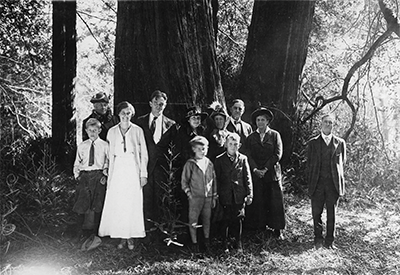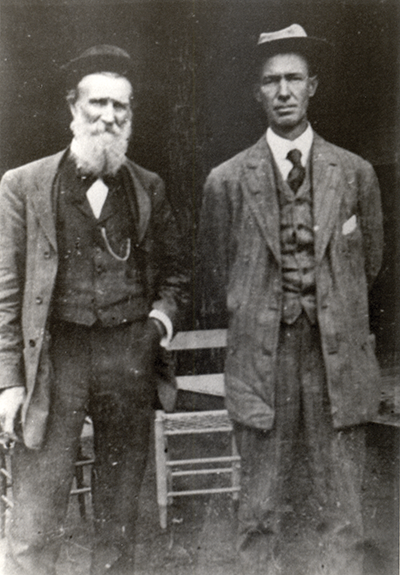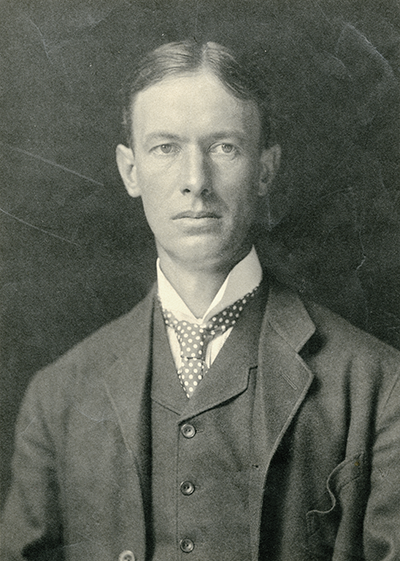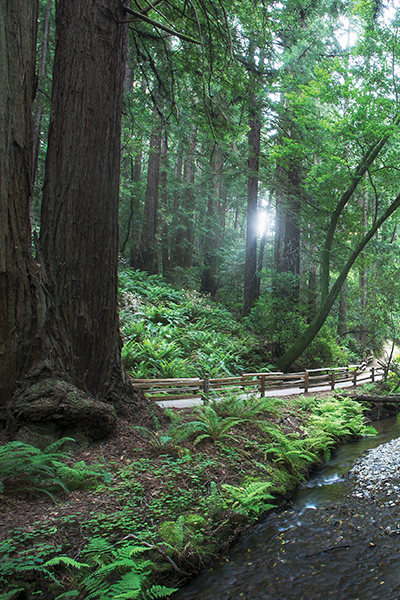MUIR WOODS NEVER DISAPPOINTS. Not in August, when you’re taking your cousins from Phoenix to see the big trees and you contend with the crowds but it’s worth it. And certainly not now, in autumn, when it’s just you and the redwoods.
You walk the trail that parallels Redwood Creek. You look at the groves of Sequoia sempervirens, which echo cathedral naves in the way they direct your eyes unerringly upward. You think of the guy the woods were named after — John Muir, the author-naturalist who taught Americans to cherish their forests and mountains.
The trail climbs a small slope toward an immense toppled tree, stretching across the forest floor for what seems like a mile. Beside the tree rests a boulder wearing a weathered metal plaque:
WILLIAM KENT Who Gave These Woods And Other Natural Beauty Sites To Perpetuate Them For People Who Love The Out-of-Doors
You think, Who? John Muir you’ve heard of. William Kent, no. But William Kent is why you can admire the redwoods rising around you. It’s not true to say Kent is forgotten — his surname still dots Marin County. Yet it’s not a household word, which is a little odd, given how much he did to make the county what it is today.
WILLIAM KENT’S CAREER and life centered around Marin. But to get a fix on him you need to go 3,000 miles east, to the Manuscripts and Archives Room of Sterling Memorial Library at Yale University, Kent’s alma mater. Here you can sort through box after box — 85 in all — of Kent letters, Kent writings and Kent memorabilia.
He was born in Chicago in 1864, youngest son of Albert and Adaline Kent. His biography (prep school, Yale, country estate) and his photographs (patrician, handsome) make him seem old money, but he wasn’t, really. His father was a farm boy who made a bundle in Chicago, first in meatpacking, then real estate. Albert Kent was an astute businessman, but unstable: “subject to tremendous fits of depression,” his son recalled. Weary of Chicago business life, in 1871 he moved his family to the Eden he’d glimpsed on a California hunting trip: the rural expanses of Marin County.

The move changed 7-year-old William’s life. “I had been a somewhat delicate and precocious child,” he wrote later. “A change to a ranch house … was sudden and I believe beneficial.” He joined his father on hunting and fishing trips; he acquired a hunting dog, Flash, and a pony named Sting Bug. His grandson, Sherman, says that family lore fixed Kent as “a first-class if not world-class shot.” In adulthood his hunting pals placed him among the 10 best in the country, after such legendary sharpshooters as Buffalo Bill and Annie Oakley.
But it wasn’t just hunting Kent took to — it was the whole California outdoors. His upbringing was anything but uncivilized. The family estate, Tamalpais, which later became the nucleus of Kentfield, was, as historian Dewey Livingston notes in his book In the Heart of Marin, “a fashionable and pretty homestead.” Yet it was Marin’s canyons and mountains that drew Kent’s devotion. His memoir Reminiscences of Outdoor Life is all hiking and hunting and fishing. He also penned not-half-bad comic poems about the animals he encountered in the wild:
THE MELANCHOLY COYOTE The kiote wails around the ranch His wasted youth and empty paunch The patient night must hear his pleas Until he stops to nibble fleas

In his teens, Kent was semi-exiled from paradise — sent east to prep school, then Yale. He met his wife-to-be, Elizabeth Thacher, later a forceful presence in Marin life herself. After marriage they moved to Chicago, where Kent managed his father’s investments. Chicago taught him politics. It was the start of the Progressive Era — a reaction to the corrupt Gilded Age. Progressives like Kent wanted government to be transparent, efficient. He ran, successfully, for Chicago city council. He and Elizabeth had seven children: five boys, two girls.
But Marin called. William came west often to visit his parents and in 1907 moved his family permanently to the Kent estate. He threw himself into community life, among other things lobbying against the “numerous and irresponsible” saloons of San Rafael.
AND HE RESCUED the big trees. Prime lumber for growing cities, coast redwoods were being felled up and down Northern California. The clock was ticking for those in nearby Redwood Canyon, which Kent was familiar with from hunting trips. “Why don’t you buy the trees?” asked a friend. Even for Kent, the $45,000 price tag was steep. But he and Elizabeth went ahead, acquiring the canyon land near Mill Valley in 1905. “After all,” he told his wife, “if we lost all the money we had and saved these trees, it would be worthwhile, wouldn’t it?”
But the redwoods remained endangered. A local water company tried to condemn the canyon to build a reservoir. Kent had an inspiration. The just-passed Antiquities Act of 1906 let the president set aside worthy lands as national monuments. Kent lobbied Teddy Roosevelt’s administration to accept his gift of the trees. On January 9, 1908, 298 acres of Redwood Canyon became a national monument.
But what to call it? Kent suggested it be named for Muir, although the two men had not yet met. Roosevelt protested — the woods should honor their donor. No, Kent demurred, he had “five good, husky boys” to keep the Kent name alive. “By George! you are right,” replied T.R. Muir Woods it was, and the wilderness sage was effusive with gratitude: “This is the best tree-lovers’ monument that could possibly be found in all the forests of the world.” Muir and Kent became friends, Kent calling him “one of the most interesting people I have ever met.”

THE GIFT OF MUIR WOODS was such a splashy act of generosity it overshadows the rest of Kent’s career. But there was much left for him to accomplish. In 1910 he ran for Congress as a Progressive Republican and won; he served two additional terms as an Independent. He sponsored the legislation that created the National Park System in 1916; on the home front he helped create the Marin Municipal Water District and pushed to set aside Mount Tamalpais as a park. Meanwhile, Elizabeth Kent became a passionate advocate for women’s suffrage. “She would get arrested,” recalls Kent’s granddaughter Molly Schardt. “William had to bail her out. He would get quite cross. But when friends told him ‘Get your wife in order,’ he said ‘No, I value my independence so much I cannot infringe on hers.’ ”
The Kent record is not without blemishes. Progressivism had its dark sides: Teddy Roosevelt’s imperialism, Woodrow Wilson’s prejudice against African Americans. Kent displayed a now-distasteful animus against Asian immigrants. Within a few years, his friendship with Muir shattered over his support for the plan to build a dam in Yosemite’s Hetch Hetchy Valley — a project that, a century later, still rankles lovers of national parks.
Still, when Kent died, in 1928, he was memorialized as one of the architects of Marin County, California and the nation. Says Dewey Livingston, “You get the sense that he would have been a very interesting man to know. Well-read and intelligent, but with the salt of the earth about him.” Says Molly Schardt, “He was very much his own man.” She cites the tree in Muir Woods that carries his name. Even toppled — it fell in 2003 — it’s magnificent. But in one of the most famous redwood forests in the world, it’s a Douglas fir. “All those redwoods around,” Schardt says. “But he said, ‘I want that tree.’ ” And that’s the tree he got.


